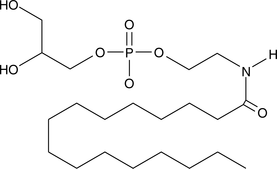Chemicals
Showing 20851–21000 of 41137 results
-
N-Acylated ethanolamines (NAE) are naturally-occurring lipids that have diverse bioactivities. For example, arachidonoyl ethanolamide (AEA) is an endogenous cannabinoid neurotransmitter that evokes cellular responses by activating the cannabinoid receptors, central cannabinoid (CB1) and peripheral cannabinoid (CB2). The different types of NAE are derived from glycerophospho-linked precursors by the activity of glycerophosphodiesterase 1 (GDE1).{15460} Glycerophospho-N-oleoyl ethanolamine is the precursor of oleoyl ethanolamide (OEA). OEA is an endogenous, potent agonist for PPARα, exhibiting an EC50 value of 120 nM in a transactivation assay.{11423} Systemic administration of OEA suppresses food intake and reduces weight gain in rats (10 mg/kg intraperitoneally) and PPARα wild-type mice, but not in PPARα knockout mice.{11423, 9302} Like AEA, OEA is metabolized by fatty acid amide hydrolase (FAAH).
Brand:CaymanSKU:10011357 - 10 mgAvailable on backorder
N-Acylated ethanolamines (NAE) are naturally-occurring lipids that have diverse bioactivities. For example, arachidonoyl ethanolamide (AEA) is an endogenous cannabinoid neurotransmitter that evokes cellular responses by activating the cannabinoid receptors, central cannabinoid (CB1) and peripheral cannabinoid (CB2). The different types of NAE are derived from glycerophospho-linked precursors by the activity of glycerophosphodiesterase 1 (GDE1).{15460} Glycerophospho-N-oleoyl ethanolamine is the precursor of oleoyl ethanolamide (OEA). OEA is an endogenous, potent agonist for PPARα, exhibiting an EC50 value of 120 nM in a transactivation assay.{11423} Systemic administration of OEA suppresses food intake and reduces weight gain in rats (10 mg/kg intraperitoneally) and PPARα wild-type mice, but not in PPARα knockout mice.{11423, 9302} Like AEA, OEA is metabolized by fatty acid amide hydrolase (FAAH).
Brand:CaymanSKU:10011357 - 5 mgAvailable on backorder
N-Acylated ethanolamines (NAE) are naturally-occurring lipids that have diverse bioactivities. For example, arachidonoyl ethanolamide (AEA) is an endogenous neurotransmitter that evokes cellular responses by activating the cannabinoid receptors, central cannabinoid (CB1) and peripheral cannabinoid (CB2). The different types of NAE are derived from glycerophospho-linked precursors by the activity of glycerophosphodiesterase 1 (GDE1).{15460} Glycerophospho-N-palmitoyl ethanolamine (GP-NPEA) is the metabolic precursor of palmitoyl ethanolamide (PEA). PEA is an endogenous cannabinoid found in brain, liver, and other mammalian tissues,{2415} that has potent anti-inflammatory activity in vivo.{16742} PEA has low affinity for peripheral cannabinoid (CB2) and no appreciable affinity for central cannabinoid (CB1),{1134} suggesting that its efficacy is through a different receptor.
Brand:CaymanSKU:10011356 - 1 mgAvailable on backorder
N-Acylated ethanolamines (NAE) are naturally-occurring lipids that have diverse bioactivities. For example, arachidonoyl ethanolamide (AEA) is an endogenous neurotransmitter that evokes cellular responses by activating the cannabinoid receptors, central cannabinoid (CB1) and peripheral cannabinoid (CB2). The different types of NAE are derived from glycerophospho-linked precursors by the activity of glycerophosphodiesterase 1 (GDE1).{15460} Glycerophospho-N-palmitoyl ethanolamine (GP-NPEA) is the metabolic precursor of palmitoyl ethanolamide (PEA). PEA is an endogenous cannabinoid found in brain, liver, and other mammalian tissues,{2415} that has potent anti-inflammatory activity in vivo.{16742} PEA has low affinity for peripheral cannabinoid (CB2) and no appreciable affinity for central cannabinoid (CB1),{1134} suggesting that its efficacy is through a different receptor.
Brand:CaymanSKU:10011356 - 10 mgAvailable on backorder
N-Acylated ethanolamines (NAE) are naturally-occurring lipids that have diverse bioactivities. For example, arachidonoyl ethanolamide (AEA) is an endogenous neurotransmitter that evokes cellular responses by activating the cannabinoid receptors, central cannabinoid (CB1) and peripheral cannabinoid (CB2). The different types of NAE are derived from glycerophospho-linked precursors by the activity of glycerophosphodiesterase 1 (GDE1).{15460} Glycerophospho-N-palmitoyl ethanolamine (GP-NPEA) is the metabolic precursor of palmitoyl ethanolamide (PEA). PEA is an endogenous cannabinoid found in brain, liver, and other mammalian tissues,{2415} that has potent anti-inflammatory activity in vivo.{16742} PEA has low affinity for peripheral cannabinoid (CB2) and no appreciable affinity for central cannabinoid (CB1),{1134} suggesting that its efficacy is through a different receptor.
Brand:CaymanSKU:10011356 - 5 mgAvailable on backorder
Glycine-β-muricholic acid (GβMCA) is an intestine-selective antagonist of the farnesoid X receptor (FXR) and the glycine-conjugated form of the murine-specific primary bile acid β-muricholic acid (Item No. 20287).{36870,45190} It inhibits expression of the FXR target genes Shp and Fgf15 induced by the FXR ligands chenodeoxycholic acid (Item No. 10011286) and GW 4064 (Item No. 10006611) in Caco-2 cells when used at a concentration of 100 μM. GβMCA is resistant to hydrolysis by fecal bile salt hydrolase (BSH) isolated from gut microbiota, indicating gut stability. Dietary administration of GβMCA (10 mg/kg) decreases Shp and Fgf15 mRNA expression in ileum, but not liver, and reduces ceramide levels and expression of the ceramide synthesis-related genes Sptlc2, Sptlc3, Cers2, Cers4, Degs1, Degs2, Smpd3, and Smpd4 in ileum of mice with high-fat diet-induced obesity and db/db mice. It also prevents weight gain, reduces blood glucose levels, and increases insulin sensitivity as well as prevents development of cholestasis and necrotic lesions in liver of mice with high-fat diet-induced obesity.
Brand:CaymanSKU:9003230 - 1 mgAvailable on backorder
Glycine-β-muricholic acid (GβMCA) is an intestine-selective antagonist of the farnesoid X receptor (FXR) and the glycine-conjugated form of the murine-specific primary bile acid β-muricholic acid (Item No. 20287).{36870,45190} It inhibits expression of the FXR target genes Shp and Fgf15 induced by the FXR ligands chenodeoxycholic acid (Item No. 10011286) and GW 4064 (Item No. 10006611) in Caco-2 cells when used at a concentration of 100 μM. GβMCA is resistant to hydrolysis by fecal bile salt hydrolase (BSH) isolated from gut microbiota, indicating gut stability. Dietary administration of GβMCA (10 mg/kg) decreases Shp and Fgf15 mRNA expression in ileum, but not liver, and reduces ceramide levels and expression of the ceramide synthesis-related genes Sptlc2, Sptlc3, Cers2, Cers4, Degs1, Degs2, Smpd3, and Smpd4 in ileum of mice with high-fat diet-induced obesity and db/db mice. It also prevents weight gain, reduces blood glucose levels, and increases insulin sensitivity as well as prevents development of cholestasis and necrotic lesions in liver of mice with high-fat diet-induced obesity.
Brand:CaymanSKU:9003230 - 10 mgAvailable on backorder
Glycine-β-muricholic acid (GβMCA) is an intestine-selective antagonist of the farnesoid X receptor (FXR) and the glycine-conjugated form of the murine-specific primary bile acid β-muricholic acid (Item No. 20287).{36870,45190} It inhibits expression of the FXR target genes Shp and Fgf15 induced by the FXR ligands chenodeoxycholic acid (Item No. 10011286) and GW 4064 (Item No. 10006611) in Caco-2 cells when used at a concentration of 100 μM. GβMCA is resistant to hydrolysis by fecal bile salt hydrolase (BSH) isolated from gut microbiota, indicating gut stability. Dietary administration of GβMCA (10 mg/kg) decreases Shp and Fgf15 mRNA expression in ileum, but not liver, and reduces ceramide levels and expression of the ceramide synthesis-related genes Sptlc2, Sptlc3, Cers2, Cers4, Degs1, Degs2, Smpd3, and Smpd4 in ileum of mice with high-fat diet-induced obesity and db/db mice. It also prevents weight gain, reduces blood glucose levels, and increases insulin sensitivity as well as prevents development of cholestasis and necrotic lesions in liver of mice with high-fat diet-induced obesity.
Brand:CaymanSKU:9003230 - 5 mgAvailable on backorder
Glycitein is an O-methylated isoflavone that comprises 5-10% of the total isoflavones in soy food products. This phytoestrogen is reported to have weak estrogenic activity, displacing estradiol binding at the estrogen receptor in vitro with an IC50 value of 3.94 μM.{22750} It suppresses the proliferation of osteoblasts and promotes differentiation from its progenitor.{22747} It has also been used to attenuate proliferation (10 μM) of aortic smooth muscle cells related to atherosclerotic vascular change in stroke-prone hypertensive rats and to protect against beta amyloid (Aβ)-induced toxicity and oxidative stress (100 μg/ml) in C. elegans expressing human Aβ.{22749,22748}
Brand:CaymanSKU:-Glycitein is an O-methylated isoflavone that comprises 5-10% of the total isoflavones in soy food products. This phytoestrogen is reported to have weak estrogenic activity, displacing estradiol binding at the estrogen receptor in vitro with an IC50 value of 3.94 μM.{22750} It suppresses the proliferation of osteoblasts and promotes differentiation from its progenitor.{22747} It has also been used to attenuate proliferation (10 μM) of aortic smooth muscle cells related to atherosclerotic vascular change in stroke-prone hypertensive rats and to protect against beta amyloid (Aβ)-induced toxicity and oxidative stress (100 μg/ml) in C. elegans expressing human Aβ.{22749,22748}
Brand:CaymanSKU:-Glycitein is an O-methylated isoflavone that comprises 5-10% of the total isoflavones in soy food products. This phytoestrogen is reported to have weak estrogenic activity, displacing estradiol binding at the estrogen receptor in vitro with an IC50 value of 3.94 μM.{22750} It suppresses the proliferation of osteoblasts and promotes differentiation from its progenitor.{22747} It has also been used to attenuate proliferation (10 μM) of aortic smooth muscle cells related to atherosclerotic vascular change in stroke-prone hypertensive rats and to protect against beta amyloid (Aβ)-induced toxicity and oxidative stress (100 μg/ml) in C. elegans expressing human Aβ.{22749,22748}
Brand:CaymanSKU:-Glycitein is an O-methylated isoflavone that comprises 5-10% of the total isoflavones in soy food products. This phytoestrogen is reported to have weak estrogenic activity, displacing estradiol binding at the estrogen receptor in vitro with an IC50 value of 3.94 μM.{22750} It suppresses the proliferation of osteoblasts and promotes differentiation from its progenitor.{22747} It has also been used to attenuate proliferation (10 μM) of aortic smooth muscle cells related to atherosclerotic vascular change in stroke-prone hypertensive rats and to protect against beta amyloid (Aβ)-induced toxicity and oxidative stress (100 μg/ml) in C. elegans expressing human Aβ.{22749,22748}
Brand:CaymanSKU:-Glycitin is a natural isoflavone isolated from legumes, including soy and kudzu. Like other isoflavones, glycitin promotes the proliferation of bone marrow stromal cells and osteoblasts and suppresses bone turnover.{22650,22649}
Brand:CaymanSKU:-Glycitin is a natural isoflavone isolated from legumes, including soy and kudzu. Like other isoflavones, glycitin promotes the proliferation of bone marrow stromal cells and osteoblasts and suppresses bone turnover.{22650,22649}
Brand:CaymanSKU:-Glycitin is a natural isoflavone isolated from legumes, including soy and kudzu. Like other isoflavones, glycitin promotes the proliferation of bone marrow stromal cells and osteoblasts and suppresses bone turnover.{22650,22649}
Brand:CaymanSKU:-Glycitin is a natural isoflavone isolated from legumes, including soy and kudzu. Like other isoflavones, glycitin promotes the proliferation of bone marrow stromal cells and osteoblasts and suppresses bone turnover.{22650,22649}
Brand:CaymanSKU:-Glyco-obeticholic acid is an active metabolite of obeticholic acid, which is a farnesoid X receptor (FXR) agonist and semisynthetic derivative of chenodeoxycholic acid (Item No. 10011286).{46303} Glyco-obeticholic acid is formed from obeticholic acid by glycine conjugation in the liver but can be reconverted back to obeticholic acid by microorganism-mediated deconjugation in the ileum and colon. It has been used as a precursor in the synthesis of bile acid analogs as agonists of the farnesoid X receptor (FXR) and TGR5.{45287}
Brand:CaymanSKU:28242 - 1 mgAvailable on backorder
Glyco-obeticholic acid is an active metabolite of obeticholic acid, which is a farnesoid X receptor (FXR) agonist and semisynthetic derivative of chenodeoxycholic acid (Item No. 10011286).{46303} Glyco-obeticholic acid is formed from obeticholic acid by glycine conjugation in the liver but can be reconverted back to obeticholic acid by microorganism-mediated deconjugation in the ileum and colon. It has been used as a precursor in the synthesis of bile acid analogs as agonists of the farnesoid X receptor (FXR) and TGR5.{45287}
Brand:CaymanSKU:28242 - 5 mgAvailable on backorder
Glycochenodeoxycholic acid (GCDCA) is a glycine-conjugated form of the primary bile acid chenodeoxycholic acid (Item No. 10011286).{57144} It reduces formation of cholic acid (Item No. 20250) in primary human hepatocytes when used at a concentration of 100 µM.{57145} GCDCA (50, 75, and 100 µM) reduces the number LC3 puncta, a marker of autophagy, and is cytotoxic to L-02 hepatocytes.{57144} GCDCA (50 µM) induces apoptosis in isolated rat hepatocytes, an effect that can be blocked by the protein kinase C (PKC) inhibitor chelerythrine (Item No. 11314).{57146} Fecal levels of GCDCA are decreased in a rat model of high-fat diet-induced obesity compared with rats fed a normal diet.{54007} Glycochenodeoxycholic acid MaxSpec® standard is a quantitative grade standard of glycochenodeoxycholic acid (Item No. 16942) that has been prepared specifically for mass spectrometry and related applications where quantitative reproducibility is required. The solution has been prepared gravimetrically and is supplied in a deactivated glass ampule sealed under argon. The concentration was verified by comparison to an independently prepared calibration standard. This Glycochenodeoxycholic acid MaxSpec® standard is guaranteed to meet identity, purity, stability, and concentration specifications and is provided with a batch-specific certificate of analysis. Ongoing stability testing is performed to ensure the concentration remains accurate throughout the shelf life of the product. Note: The amount of solution added to the vial is in excess of the listed amount. Therefore, it is necessary to accurately measure volumes for preparation of calibration standards. Follow recommended storage and handling conditions to maintain product quality.
Brand:CaymanSKU:31363 - 100 µgAvailable on backorder
An internal standard for the quantification of glycochenodeoxycholic acid (GCDCA; Item No. 16942) by GC- or LC-MS. GCDCA is a glycine-conjugated form of the primary bile acid chenodeoxycholic acid (Item No. 10011286).{57144} It reduces formation of cholic acid (Item No. 20250) in primary human hepatocytes when used at a concentration of 100 µM.{57145} GCDCA (50, 75, and 100 µM) reduces the number LC3 puncta, a marker of autophagy, and is cytotoxic to L-02 hepatocytes.{57144} GCDCA (50 µM) induces apoptosis in isolated rat hepatocytes, an effect that can be blocked by the protein kinase C (PKC) inhibitor chelerythrine (Item No. 11314).{57146} Fecal levels of GCDCA are decreased in a rat model of high-fat diet-induced obesity compared with rats fed a normal diet.{54007}
Brand:CaymanSKU:21890 -Out of stock
Glycocholic acid is a glycine-conjugated form of the primary bile acid cholic acid (Item No. 20250) and has roles in the emulsification of fats.{48223,54310} It reduces expression of the gene encoding the farnesoid X receptor (FXR) and increases expression of the genes encoding the bile acid receptors TGR5 and S1PR2 in SNU-245 cells when used at a concentration of 1.6 μmol/ml.{54311} Glycocholic acid (250 μM) increases the intracellular accumulation and cytotoxicity of epirubicin (Item No. 12091) in Caco-2 cells, as well as decreases expression of the genes encoding multidrug resistance protein 1 (MDR1), MDR-associated protein 1 (MRP1), and MRP2 when used alone or in combination with epirubicin.{54312} It increases absorption of epirubicin into everted sacs of rat ileum and jejunum when used at a concentration of 250 μM. The bile acid composition ratio of glycocholic acid is elevated in bile of patients with cholangiocarcinoma compared with patients with pancreatic cancer or benign biliary diseases.{54311} Serum levels of glycocholic acid are elevated in patients with hepatocellular carcinoma compared with healthy individuals.{54310}
Brand:CaymanSKU:20276 -Available on backorder
Glycocholic acid is a glycine-conjugated form of the primary bile acid cholic acid (Item No. 20250) and has roles in the emulsification of fats.{48223,54310} It reduces expression of the gene encoding the farnesoid X receptor (FXR) and increases expression of the genes encoding the bile acid receptors TGR5 and S1PR2 in SNU-245 cells when used at a concentration of 1.6 μmol/ml.{54311} Glycocholic acid (250 μM) increases the intracellular accumulation and cytotoxicity of epirubicin (Item No. 12091) in Caco-2 cells, as well as decreases expression of the genes encoding multidrug resistance protein 1 (MDR1), MDR-associated protein 1 (MRP1), and MRP2 when used alone or in combination with epirubicin.{54312} It increases absorption of epirubicin into everted sacs of rat ileum and jejunum when used at a concentration of 250 μM. The bile acid composition ratio of glycocholic acid is elevated in bile of patients with cholangiocarcinoma compared with patients with pancreatic cancer or benign biliary diseases.{54311} Serum levels of glycocholic acid are elevated in patients with hepatocellular carcinoma compared with healthy individuals.{54310}
Brand:CaymanSKU:20276 -Available on backorder
Glycocholic acid is a glycine-conjugated form of the primary bile acid cholic acid (Item No. 20250) and has roles in the emulsification of fats.{48223,54310} It reduces expression of the gene encoding the farnesoid X receptor (FXR) and increases expression of the genes encoding the bile acid receptors TGR5 and S1PR2 in SNU-245 cells when used at a concentration of 1.6 μmol/ml.{54311} Glycocholic acid (250 μM) increases the intracellular accumulation and cytotoxicity of epirubicin (Item No. 12091) in Caco-2 cells, as well as decreases expression of the genes encoding multidrug resistance protein 1 (MDR1), MDR-associated protein 1 (MRP1), and MRP2 when used alone or in combination with epirubicin.{54312} It increases absorption of epirubicin into everted sacs of rat ileum and jejunum when used at a concentration of 250 μM. The bile acid composition ratio of glycocholic acid is elevated in bile of patients with cholangiocarcinoma compared with patients with pancreatic cancer or benign biliary diseases.{54311} Serum levels of glycocholic acid are elevated in patients with hepatocellular carcinoma compared with healthy individuals.{54310}
Brand:CaymanSKU:20276 -Available on backorder
Glycocholic acid is a glycine-conjugated form of the primary bile acid cholic acid (Item No. 20250) and has roles in the emulsification of fats.{48223,54310} It reduces expression of the gene encoding the farnesoid X receptor (FXR) and increases expression of the genes encoding the bile acid receptors TGR5 and S1PR2 in SNU-245 cells when used at a concentration of 1.6 μmol/ml.{54311} Glycocholic acid (250 μM) increases the intracellular accumulation and cytotoxicity of epirubicin (Item No. 12091) in Caco-2 cells, as well as decreases expression of the genes encoding multidrug resistance protein 1 (MDR1), MDR-associated protein 1 (MRP1), and MRP2 when used alone or in combination with epirubicin.{54312} It increases absorption of epirubicin into everted sacs of rat ileum and jejunum when used at a concentration of 250 μM. The bile acid composition ratio of glycocholic acid is elevated in the bile of patients with cholangiocarcinoma compared with patients with pancreatic cancer or benign biliary diseases.{54311} Serum levels of glycocholic acid are elevated in patients with hepatocellular carcinoma compared with healthy individuals.{54310} Glycocholic acid MaxSpec® standard is a quantitative grade standard of glycocholic acid (Item No. 20276) that has been prepared specifically for mass spectrometry and related applications where quantitative reproducibility is required. The solution has been prepared gravimetrically and is supplied in a deactivated glass ampule sealed under argon. The concentration was verified by comparison to an independently prepared calibration standard. This glycocholic acid MaxSpec® standard is guaranteed to meet identity, purity, stability, and concentration specifications and is provided with a batch-specific certificate of analysis. Ongoing stability testing is performed to ensure the concentration remains accurate throughout the shelf life of the product. Note: The amount of solution added to the vial is in excess of the listed amount. Therefore, it is necessary to accurately measure volumes for preparation of calibration standards. Follow recommended storage and handling conditions to maintain product quality.
Brand:CaymanSKU:31351 - 100 µgAvailable on backorder
Glycocholic acid-d4 is intended for use as an internal standard for the quantification of glycocholic acid (Item No. 20276) by GC- or LC-MS. Glycocholic acid is a glycine-conjugated form of the primary bile acid cholic acid (Item No. 20250) and has roles in the emulsification of fats.{48223,54310} It reduces expression of the gene encoding the farnesoid X receptor (FXR) and increases expression of the genes encoding the bile acid receptors TGR5 and S1PR2 in SNU-245 cells when used at a concentration of 1.6 μmol/ml.{54311} Glycocholic acid (250 μM) increases the intracellular accumulation and cytotoxicity of epirubicin (Item No. 12091) in Caco-2 cells, as well as decreases expression of the genes encoding multidrug resistance protein 1 (MDR1), MDR-associated protein 1 (MRP1), and MRP2 when used alone or in combination with epirubicin.{54312} It increases absorption of epirubicin into everted sacs of rat ileum and jejunum when used at a concentration of 250 μM. The bile acid composition ratio of glycocholic acid is elevated in bile of patients with cholangiocarcinoma compared with patients with pancreatic cancer or benign biliary diseases.{54311} Serum levels of glycocholic acid are elevated in patients with hepatocellular carcinoma compared with healthy individuals.{54310}
Brand:CaymanSKU:21889 -Out of stock
Glycocholic acid-d4 is intended for use as an internal standard for the quantification of glycocholic acid (Item No. 20276) by GC- or LC-MS. Glycocholic acid is a glycine-conjugated form of the primary bile acid cholic acid (Item No. 20250) and has roles in the emulsification of fats.{48223,54310} It reduces expression of the gene encoding the farnesoid X receptor (FXR) and increases expression of the genes encoding the bile acid receptors TGR5 and S1PR2 in SNU-245 cells when used at a concentration of 1.6 μmol/ml.{54311} Glycocholic acid (250 μM) increases the intracellular accumulation and cytotoxicity of epirubicin (Item No. 12091) in Caco-2 cells, as well as decreases expression of the genes encoding multidrug resistance protein 1 (MDR1), MDR-associated protein 1 (MRP1), and MRP2 when used alone or in combination with epirubicin.{54312} It increases absorption of epirubicin into everted sacs of rat ileum and jejunum when used at a concentration of 250 μM. The bile acid composition ratio of glycocholic acid is elevated in bile of patients with cholangiocarcinoma compared with patients with pancreatic cancer or benign biliary diseases.{54311} Serum levels of glycocholic acid are elevated in patients with hepatocellular carcinoma compared with healthy individuals.{54310}
Brand:CaymanSKU:21889 -Out of stock
Glycocholic acid-d4 is intended for use as an internal standard for the quantification of glycocholic acid (Item No. 20276) by GC- or LC-MS. Glycocholic acid is a glycine-conjugated form of the primary bile acid cholic acid (Item No. 20250) and has roles in the emulsification of fats.{48223,54310} It reduces expression of the gene encoding the farnesoid X receptor (FXR) and increases expression of the genes encoding the bile acid receptors TGR5 and S1PR2 in SNU-245 cells when used at a concentration of 1.6 μmol/ml.{54311} Glycocholic acid (250 μM) increases the intracellular accumulation and cytotoxicity of epirubicin (Item No. 12091) in Caco-2 cells, as well as decreases expression of the genes encoding multidrug resistance protein 1 (MDR1), MDR-associated protein 1 (MRP1), and MRP2 when used alone or in combination with epirubicin.{54312} It increases absorption of epirubicin into everted sacs of rat ileum and jejunum when used at a concentration of 250 μM. The bile acid composition ratio of glycocholic acid is elevated in bile of patients with cholangiocarcinoma compared with patients with pancreatic cancer or benign biliary diseases.{54311} Serum levels of glycocholic acid are elevated in patients with hepatocellular carcinoma compared with healthy individuals.{54310} Glycocholic acid-d4 MaxSpec® standard is a quantitative grade standard of glycocholic acid-d4 (Item No. 21889) that has been prepared specifically for mass spectrometry and related applications where quantitative reproducibility is required. The solution has been prepared gravimetrically and is supplied in a deactivated glass ampule sealed under argon. The concentration was verified by comparison to an independently prepared calibration standard. This glycocholic acid-d4 MaxSpec® standard is guaranteed to meet identity, purity, stability, and concentration specifications and is provided with a batch-specific certificate of analysis. Ongoing stability testing is performed to ensure the concentration remains accurate throughout the shelf life of the product. Note: The amount of solution added to the vial is in excess of the listed amount. Therefore, it is necessary to accurately measure volumes for preparation of calibration standards. Follow recommended storage and handling conditions to maintain product quality.
Brand:CaymanSKU:31352 - 100 µgAvailable on backorder
Glycodehydrocholic acid is a glycine-conjugated form of the synthetic bile acid dehydrocholic acid (Item No. 29176).{49590}
Brand:CaymanSKU:29892 - 10 mgAvailable on backorder
Glycodehydrocholic acid is a glycine-conjugated form of the synthetic bile acid dehydrocholic acid (Item No. 29176).{49590}
Brand:CaymanSKU:29892 - 25 mgAvailable on backorder
Glycodehydrocholic acid is a glycine-conjugated form of the synthetic bile acid dehydrocholic acid (Item No. 29176).{49590}
Brand:CaymanSKU:29892 - 5 mgAvailable on backorder
Glycodehydrocholic acid is a glycine-conjugated form of the synthetic bile acid dehydrocholic acid (Item No. 29176).{49590}
Brand:CaymanSKU:29892 - 50 mgAvailable on backorder
Glycodeoxycholic acid (GDCA) is a glycine-conjugated form of the secondary bile acid deoxycholic acid (Item Nos. 18231 | 20756).{48223} It induces a reversible, concentration-dependent reduction in myogenic tone in rats and decreases expression of the gene encoding the cytochrome P450 (CYP) isoform 7A1 (CYP7A1) in rabbits.{33912,33913} Serum levels of GDCA are elevated in non-surviving patients with acetaminophen-induced acute liver failure (AALF) compared with survivors.{33914} GDCA levels are also increased in the plasma of patients with asthma.{33911}
Brand:CaymanSKU:20274 -Available on backorder
Glycodeoxycholic acid (GDCA) is a glycine-conjugated form of the secondary bile acid deoxycholic acid (Item Nos. 18231 | 20756).{48223} It induces a reversible, concentration-dependent reduction in myogenic tone in rats and decreases expression of the gene encoding the cytochrome P450 (CYP) isoform 7A1 (CYP7A1) in rabbits.{33912,33913} Serum levels of GDCA are elevated in non-surviving patients with acetaminophen-induced acute liver failure (AALF) compared with survivors.{33914} GDCA levels are also increased in the plasma of patients with asthma.{33911}
Brand:CaymanSKU:20274 -Available on backorder
Glycodeoxycholic acid (GDCA) is a glycine-conjugated form of the secondary bile acid deoxycholic acid (Item Nos. 18231 | 20756).{48223} It induces a reversible, concentration-dependent reduction in myogenic tone in rats and decreases expression of the gene encoding the cytochrome P450 (CYP) isoform 7A1 (CYP7A1) in rabbits.{33912,33913} Serum levels of GDCA are elevated in non-surviving patients with acetaminophen-induced acute liver failure (AALF) compared with survivors.{33914} GDCA levels are also increased in the plasma of patients with asthma.{33911}
Brand:CaymanSKU:20274 -Available on backorder
Glycodeoxycholic acid (GDCA) is a glycine-conjugated form of the secondary bile acid deoxycholic acid (Item Nos. 18231 | 20756).{48223} It induces a reversible, concentration-dependent reduction in myogenic tone in rats and decreases expression of the gene encoding the cytochrome P450 (CYP) isoform 7A1 (CYP7A1) in rabbits.{33912,33913} Serum levels of GDCA are elevated in non-surviving patients with acetaminophen-induced acute liver failure (AALF) compared with survivors.{33914} GDCA levels are also increased in the plasma of patients with asthma.{33911}
Brand:CaymanSKU:20274 -Available on backorder
Glycodeoxycholic acid (GDCA) is a glycine-conjugated form of the secondary bile acid deoxycholic acid (Item Nos. 18231 | 20756).{48223} It induces a reversible, concentration-dependent reduction in myogenic tone in rats and decreases expression of the gene encoding the cytochrome P450 (CYP) isoform 7A1 (CYP7A1) in rabbits.{33912,33913} Serum levels of GDCA are elevated in non-surviving patients with acetaminophen-induced acute liver failure (AALF) compared with survivors.{33914} GDCA levels are also increased in the plasma of patients with asthma.{33911} GDCA MaxSpec® standard is a quantitative grade standard of glycodeoxycholic acid (Item No. 20274) that has been prepared specifically for mass spectrometry and related applications where quantitative reproducibility is required. The solution has been prepared gravimetrically and is supplied in a deactivated glass ampule sealed under argon. The concentration was verified by comparison to an independently prepared calibration standard. This GDCA MaxSpec® standard is guaranteed to meet identity, purity, stability, and concentration specifications and is provided with a batch-specific certificate of analysis. Ongoing stability testing is performed to ensure the concentration remains accurate throughout the shelf life of the product. Note: The amount of solution added to the vial is in excess of the listed amount. Therefore, it is necessary to accurately measure volumes for preparation of calibration standards. Follow recommended storage and handling conditions to maintain product quality.
Brand:CaymanSKU:31599 - 100 µgAvailable on backorder
Glycodeoxycholic acid-d4 is intended for use as an internal standard for the quantification of glycodeoxycholic acid (Item No. 20274) by GC- or LC-MS. Glycodeoxycholic acid (GDCA) is a glycine-conjugated form of the secondary bile acid deoxycholic acid (Item Nos. 18231 | 20756).{48223} It induces a reversible, concentration-dependent reduction in myogenic tone in rats and decreases expression of the gene encoding the cytochrome P450 (CYP) isoform 7A1 (CYP7A1) in rabbits.{33912,33913} Serum levels of GDCA are elevated in non-surviving patients with acetaminophen-induced acute liver failure (AALF) compared with survivors.{33914} GDCA levels are also increased in the plasma of patients with asthma.{33911}
Brand:CaymanSKU:31310 - 1 mgAvailable on backorder
Glycodeoxycholic acid-d4 is intended for use as an internal standard for the quantification of glycodeoxycholic acid (Item No. 20274) by GC- or LC-MS. Glycodeoxycholic acid (GDCA) is a glycine-conjugated form of the secondary bile acid deoxycholic acid (Item Nos. 18231 | 20756).{48223} It induces a reversible, concentration-dependent reduction in myogenic tone in rats and decreases expression of the gene encoding the cytochrome P450 (CYP) isoform 7A1 (CYP7A1) in rabbits.{33912,33913} Serum levels of GDCA are elevated in non-surviving patients with acetaminophen-induced acute liver failure (AALF) compared with survivors.{33914} GDCA levels are also increased in the plasma of patients with asthma.{33911}
Brand:CaymanSKU:31310 - 5 mgAvailable on backorder
Glycodeoxycholic acid-d4 is intended for use as an internal standard for the quantification of glycodeoxycholic acid (Item No. 20274) by GC- or LC-MS. Glycodeoxycholic acid (GDCA) is a glycine-conjugated form of the secondary bile acid deoxycholic acid (Item Nos. 18231 | 20756).{48223} It induces a reversible, concentration-dependent reduction in myogenic tone in rats and decreases expression of the gene encoding the cytochrome P450 (CYP) isoform 7A1 (CYP7A1) in rabbits.{33912,33913} Serum levels of GDCA are elevated in non-surviving patients with acetaminophen-induced acute liver failure (AALF) compared with survivors.{33914} GDCA levels are also increased in the plasma of patients with asthma.{33911}
Brand:CaymanSKU:31310 - 500 µgAvailable on backorder
Glycogen phosphorylase in the liver, muscle, and brain initiate glycogenolysis by releasing glucose-1-phosphate from glycogen. Glycogen phosphorylase inhibitor is a cell-permeable acyl urea first identified as an inhibitor of human liver glycogen phosphorylase (IC50 = 53 nM).{28561} It blocks glucagon-induced hepatic glycogenolysis in vivo.{28561} Glycogen phosphorylase inhibitor has been used to study glycogen utilization in human liver HepG2 cells, retinal explants, and human T lymphocyte Kit 225 cells.{28560,28558,28559}
Brand:CaymanSKU:-Available on backorder
Glycogen phosphorylase in the liver, muscle, and brain initiate glycogenolysis by releasing glucose-1-phosphate from glycogen. Glycogen phosphorylase inhibitor is a cell-permeable acyl urea first identified as an inhibitor of human liver glycogen phosphorylase (IC50 = 53 nM).{28561} It blocks glucagon-induced hepatic glycogenolysis in vivo.{28561} Glycogen phosphorylase inhibitor has been used to study glycogen utilization in human liver HepG2 cells, retinal explants, and human T lymphocyte Kit 225 cells.{28560,28558,28559}
Brand:CaymanSKU:-Available on backorder
Glycohyocholic acid (GHCA) is a glycine-conjugated form of the primary bile acid hyocholic acid (Item No. 20293).{40620} GHCA is upregulated 6.6-fold in the serum of patients with cirrhosis induced by hepatitis C virus (HCV) compared to healthy controls.{40624} Plasma levels of GHCA increase in patients who are no longer diabetic following gastric bypass surgery.{40625}
Brand:CaymanSKU:22670 -Out of stock
Glycohyocholic acid (GHCA) is a glycine-conjugated form of the primary bile acid hyocholic acid (Item No. 20293).{40620} GHCA is upregulated 6.6-fold in the serum of patients with cirrhosis induced by hepatitis C virus (HCV) compared to healthy controls.{40624} Plasma levels of GHCA increase in patients who are no longer diabetic following gastric bypass surgery.{40625}
Brand:CaymanSKU:22670 -Out of stock
Glycohyocholic acid (GHCA) is a glycine-conjugated form of the primary bile acid hyocholic acid (Item No. 20293).{40620} GHCA is upregulated 6.6-fold in the serum of patients with cirrhosis induced by hepatitis C virus (HCV) compared to healthy controls.{40624} Plasma levels of GHCA increase in patients who are no longer diabetic following gastric bypass surgery.{40625}
Brand:CaymanSKU:22670 -Out of stock
Glycohyocholic acid (GHCA) is a glycine-conjugated form of the primary bile acid hyocholic acid (Item No. 20293).{40620} GHCA is upregulated 6.6-fold in the serum of patients with cirrhosis induced by hepatitis C virus (HCV) compared to healthy controls.{40624} Plasma levels of GHCA increase in patients who are no longer diabetic following gastric bypass surgery.{40625}
Brand:CaymanSKU:22670 -Out of stock
Glycohyodeoxycholic acid is a major metabolite of the secondary bile acid hyodeoxycholic acid (Item No. 20294) in humans.{37127} Glycohyodeoxycholic acid supplementation in prairie dogs fed a lithogenic diet decreases the frequency of cholesterol crystals in the gallbladder and inhibits the activity of cholesterol 7α-hydroxylase.{37126}
Brand:CaymanSKU:22643 -Out of stock
Glycohyodeoxycholic acid is a major metabolite of the secondary bile acid hyodeoxycholic acid (Item No. 20294) in humans.{37127} Glycohyodeoxycholic acid supplementation in prairie dogs fed a lithogenic diet decreases the frequency of cholesterol crystals in the gallbladder and inhibits the activity of cholesterol 7α-hydroxylase.{37126}
Brand:CaymanSKU:22643 -Out of stock
Glycohyodeoxycholic acid is a major metabolite of the secondary bile acid hyodeoxycholic acid (Item No. 20294) in humans.{37127} Glycohyodeoxycholic acid supplementation in prairie dogs fed a lithogenic diet decreases the frequency of cholesterol crystals in the gallbladder and inhibits the activity of cholesterol 7α-hydroxylase.{37126}
Brand:CaymanSKU:22643 -Out of stock
Glycohyodeoxycholic acid is a major metabolite of the secondary bile acid hyodeoxycholic acid (Item No. 20294) in humans.{37127} Glycohyodeoxycholic acid supplementation in prairie dogs fed a lithogenic diet decreases the frequency of cholesterol crystals in the gallbladder and inhibits the activity of cholesterol 7α-hydroxylase.{37126}
Brand:CaymanSKU:22643 -Out of stock
Glycohyodeoxycholic acid is a major metabolite of the secondary bile acid hyodeoxycholic acid (Item No. 20294) in humans.{37127} Glycohyodeoxycholic acid supplementation in prairie dogs fed a lithogenic diet decreases the frequency of cholesterol crystals in the gallbladder and inhibits the activity of cholesterol 7α-hydroxylase.{37126} Glycohyodeoxycholic acid MaxSpec® standard is a quantitative grade standard of glycohyodeoxycholic acid (Item No. 22643) that has been prepared specifically for mass spectrometry and related applications where quantitative reproducibility is required. The solution has been prepared gravimetrically and is supplied in a deactivated glass ampule sealed under argon. The concentration was verified by comparison to an independently prepared calibration standard. This glycohyodeoxycholic acid MaxSpec® standard is guaranteed to meet identity, purity, stability, and concentration specifications and is provided with a batch-specific certificate of analysis. Ongoing stability testing is performed to ensure the concentration remains accurate throughout the shelf life of the product. Note: The amount of solution added to the vial is in excess of the listed amount. Therefore, it is necessary to accurately measure volumes for preparation of calibration standards. Follow recommended storage and handling conditions to maintain product quality.
Brand:CaymanSKU:31600 - 100 µgAvailable on backorder
Glycolithocholic acid is a glycine-conjugated form of the secondary bile acid lithocholic acid (Item No. 20253).{48223} It is increased in the liver of mice fed a diet supplemented with ursodeoxycholic acid (Item No. 15121).{30823} Glycolithocholic acid levels are decreased in the plasma following subcutaneous administration of PEG-obestatin(Cys10, Cys13), a modified peptide hormone, in lean or diet-induced obese mice.{32037} Serum glycolithocholic acid levels increase with age in children.{32038}
Brand:CaymanSKU:21723 -Out of stock
Glycolithocholic acid is a glycine-conjugated form of the secondary bile acid lithocholic acid (Item No. 20253).{48223} It is increased in the liver of mice fed a diet supplemented with ursodeoxycholic acid (Item No. 15121).{30823} Glycolithocholic acid levels are decreased in the plasma following subcutaneous administration of PEG-obestatin(Cys10, Cys13), a modified peptide hormone, in lean or diet-induced obese mice.{32037} Serum glycolithocholic acid levels increase with age in children.{32038}
Brand:CaymanSKU:21723 -Out of stock
Glycolithocholic acid is a glycine-conjugated form of the secondary bile acid lithocholic acid (Item No. 20253).{48223} It is increased in the liver of mice fed a diet supplemented with ursodeoxycholic acid (Item No. 15121).{30823} Glycolithocholic acid levels are decreased in the plasma following subcutaneous administration of PEG-obestatin(Cys10, Cys13), a modified peptide hormone, in lean or diet-induced obese mice.{32037} Serum glycolithocholic acid levels increase with age in children.{32038}
Brand:CaymanSKU:21723 -Out of stock
Glycolithocholic acid is a glycine-conjugated form of the secondary bile acid lithocholic acid (Item No. 20253).{48223} It is increased in the liver of mice fed a diet supplemented with ursodeoxycholic acid (Item No. 15121).{30823} Glycolithocholic acid levels are decreased in the plasma following subcutaneous administration of PEG-obestatin(Cys10, Cys13), a modified peptide hormone, in lean or diet-induced obese mice.{32037} Serum glycolithocholic acid levels increase with age in children.{32038}
Brand:CaymanSKU:21723 -Out of stock
Glycolithocholic acid is a glycine-conjugated form of the secondary bile acid lithocholic acid (Item No. 20253).{48223} It is increased in the liver of mice fed a diet supplemented with ursodeoxycholic acid (Item No. 15121).{30823} Glycolithocholic acid levels are decreased in the plasma following subcutaneous administration of PEG-obestatin(Cys10, Cys13), a modified peptide hormone, in lean or diet-induced obese mice.{32037} Serum glycolithocholic acid levels increase with age in children.{32038}
Brand:CaymanSKU:20273 -Available on backorder
Glycolithocholic acid is a glycine-conjugated form of the secondary bile acid lithocholic acid (Item No. 20253).{48223} It is increased in the liver of mice fed a diet supplemented with ursodeoxycholic acid (Item No. 15121).{30823} Glycolithocholic acid levels are decreased in the plasma following subcutaneous administration of PEG-obestatin(Cys10, Cys13), a modified peptide hormone, in lean or diet-induced obese mice.{32037} Serum glycolithocholic acid levels increase with age in children.{32038}
Brand:CaymanSKU:20273 -Available on backorder
Glycolithocholic acid is a glycine-conjugated form of the secondary bile acid lithocholic acid (Item No. 20253).{48223} It is increased in the liver of mice fed a diet supplemented with ursodeoxycholic acid (Item No. 15121).{30823} Glycolithocholic acid levels are decreased in the plasma following subcutaneous administration of PEG-obestatin(Cys10, Cys13), a modified peptide hormone, in lean or diet-induced obese mice.{32037} Serum glycolithocholic acid levels increase with age in children.{32038}
Brand:CaymanSKU:20273 -Available on backorder
Glycolithocholic acid is a glycine-conjugated form of the secondary bile acid lithocholic acid (Item No. 20253).{48223} It is increased in the liver of mice fed a diet supplemented with ursodeoxycholic acid (Item No. 15121).{30823} Glycolithocholic acid levels are decreased in the plasma following subcutaneous administration of PEG-obestatin(Cys10, Cys13), a modified peptide hormone, in lean or diet-induced obese mice.{32037} Serum glycolithocholic acid levels increase with age in children.{32038}
Brand:CaymanSKU:20273 -Available on backorder
Glycolithocholic acid is a glycine-conjugated form of the secondary bile acid lithocholic acid (Item No. 20253).{48223} It is increased in the liver of mice fed a diet supplemented with ursodeoxycholic acid (Item No. 15121).{30823} Glycolithocholic acid levels are decreased in the plasma following subcutaneous administration of PEG-obestatin(Cys10, Cys13), a modified peptide hormone, in lean or diet-induced obese mice.{32037} Serum glycolithocholic acid levels increase with age in children.{32038} Glycolithocholic acid MaxSpec® standard is a quantitative grade standard of glycolithocholic acid (Item Nos. 21723 | 20273) that has been prepared specifically for mass spectrometry and related applications where quantitative reproducibility is required. The solution has been prepared gravimetrically and is supplied in a deactivated glass ampule sealed under argon. The concentration was verified by comparison to an independently prepared calibration standard. This glycolithocholic acid MaxSpec® standard is guaranteed to meet identity, purity, stability, and concentration specifications and is provided with a batch-specific certificate of analysis. Ongoing stability testing is performed to ensure the concentration remains accurate throughout the shelf life of the product. Note: The amount of solution added to the vial is in excess of the listed amount. Therefore, it is necessary to accurately measure volumes for preparation of calibration standards. Follow recommended storage and handling conditions to maintain product quality.
Brand:CaymanSKU:31601 - 100 µgAvailable on backorder
Glycolithocholic acid-d4 is intended for use as an internal standard for the quantification of glycolithocholic acid (Item No. 21723) by GC- or LC-MS. Glycolithocholic acid is a glycine-conjugated form of the secondary bile acid lithocholic acid (Item No. 20253).{48223} It is increased in the liver of mice fed a diet supplemented with ursodeoxycholic acid (Item No. 15121).{30823} Glycolithocholic acid levels are decreased in the plasma following subcutaneous administration of PEG-obestatin(Cys10, Cys13), a modified peptide hormone, in lean or diet-induced obese mice.{32037} Serum glycolithocholic acid levels increase with age in children.{32038}
Brand:CaymanSKU:31308 - 1 mgAvailable on backorder
Glycolithocholic acid-d4 is intended for use as an internal standard for the quantification of glycolithocholic acid (Item No. 21723) by GC- or LC-MS. Glycolithocholic acid is a glycine-conjugated form of the secondary bile acid lithocholic acid (Item No. 20253).{48223} It is increased in the liver of mice fed a diet supplemented with ursodeoxycholic acid (Item No. 15121).{30823} Glycolithocholic acid levels are decreased in the plasma following subcutaneous administration of PEG-obestatin(Cys10, Cys13), a modified peptide hormone, in lean or diet-induced obese mice.{32037} Serum glycolithocholic acid levels increase with age in children.{32038}
Brand:CaymanSKU:31308 - 500 µgAvailable on backorder
Glycolithocholic acid-d4 is intended for use as an internal standard for the quantification of glycolithocholic acid (Item Nos. 21723 | 20273) by GC- or LC-MS. Glycolithocholic acid is a glycine-conjugated form of the secondary bile acid lithocholic acid (Item No. 20253).{48223} It is increased in the liver of mice fed a diet supplemented with ursodeoxycholic acid (Item No. 15121).{30823} Glycolithocholic acid levels are decreased in the plasma following subcutaneous administration of PEG-obestatin(Cys10, Cys13), a modified peptide hormone, in lean or diet-induced obese mice.{32037} Serum glycolithocholic acid levels increase with age in children.{32038} Glycolithocholic acid-d4 MaxSpec® standard is a quantitative grade standard of glycolithocholic acid-d4 (Item No. 31308) that has been prepared specifically for mass spectrometry and related applications where quantitative reproducibility is required. The solution has been prepared gravimetrically and is supplied in a deactivated glass ampule sealed under argon. The concentration was verified by comparison to an independently prepared calibration standard. This glycolithocholic acid-d4 MaxSpec® standard is guaranteed to meet identity, purity, stability, and concentration specifications and is provided with a batch-specific certificate of analysis. Ongoing stability testing is performed to ensure the concentration remains accurate throughout the shelf life of the product. Note: The amount of solution added to the vial is in excess of the listed amount. Therefore, it is necessary to accurately measure volumes for preparation of calibration standards. Follow recommended storage and handling conditions to maintain product quality.
Brand:CaymanSKU:31554 - 100 µgAvailable on backorder
Glycopyrrolate is a long-acting muscarinic receptor antagonist. It has been used as an antispasmodic agent, in some disorders of the gastrointestinal tract, and to reduce drooling with some anesthetics or certain disorders.{32602,32604,32603} Glycopyrrolate has shown bronchodilatory efficacy in clinical trials of patients with either asthma or chronic obstructive pulmonary disease.{32602}
Brand:CaymanSKU:-Out of stock
Glycopyrrolate is a long-acting muscarinic receptor antagonist. It has been used as an antispasmodic agent, in some disorders of the gastrointestinal tract, and to reduce drooling with some anesthetics or certain disorders.{32602,32604,32603} Glycopyrrolate has shown bronchodilatory efficacy in clinical trials of patients with either asthma or chronic obstructive pulmonary disease.{32602}
Brand:CaymanSKU:-Out of stock
Glycopyrrolate is a long-acting muscarinic receptor antagonist. It has been used as an antispasmodic agent, in some disorders of the gastrointestinal tract, and to reduce drooling with some anesthetics or certain disorders.{32602,32604,32603} Glycopyrrolate has shown bronchodilatory efficacy in clinical trials of patients with either asthma or chronic obstructive pulmonary disease.{32602}
Brand:CaymanSKU:-Out of stock
Glycopyrrolate is a long-acting muscarinic receptor antagonist. It has been used as an antispasmodic agent, in some disorders of the gastrointestinal tract, and to reduce drooling with some anesthetics or certain disorders.{32602,32604,32603} Glycopyrrolate has shown bronchodilatory efficacy in clinical trials of patients with either asthma or chronic obstructive pulmonary disease.{32602}
Brand:CaymanSKU:-Out of stock
Glycoursodeoxycholic acid (GUDCA) is a glycine-conjugated form of the secondary bile acid ursodeoxycholic acid (UDCA; Item No. 15121).{48223,34418} It has antioxidant effects in vitro in Barrett’s esophagus cells and primary cultured rat neurons.{34417,34415} GUDCA reduces the levels of inflammatory cytokines and prevents cell death induced by unconjugated bilirubin in an astroglial cell model of neonatal hyperbilirubinemia.{34416} Oral administration of GUDCA (500 mg/kg per day) decreases the severity of symptoms and increases the amount of A. muciniphila, a bacterial species commonly decreased in patients with inflammatory bowel disease (IBD), in a mouse model of colitis.{34418}
Brand:CaymanSKU:21698 -Out of stock
Glycoursodeoxycholic acid (GUDCA) is a glycine-conjugated form of the secondary bile acid ursodeoxycholic acid (UDCA; Item No. 15121).{48223,34418} It has antioxidant effects in vitro in Barrett’s esophagus cells and primary cultured rat neurons.{34417,34415} GUDCA reduces the levels of inflammatory cytokines and prevents cell death induced by unconjugated bilirubin in an astroglial cell model of neonatal hyperbilirubinemia.{34416} Oral administration of GUDCA (500 mg/kg per day) decreases the severity of symptoms and increases the amount of A. muciniphila, a bacterial species commonly decreased in patients with inflammatory bowel disease (IBD), in a mouse model of colitis.{34418}
Brand:CaymanSKU:21698 -Out of stock
Glycoursodeoxycholic acid (GUDCA) is a glycine-conjugated form of the secondary bile acid ursodeoxycholic acid (UDCA; Item No. 15121).{48223,34418} It has antioxidant effects in vitro in Barrett’s esophagus cells and primary cultured rat neurons.{34417,34415} GUDCA reduces the levels of inflammatory cytokines and prevents cell death induced by unconjugated bilirubin in an astroglial cell model of neonatal hyperbilirubinemia.{34416} Oral administration of GUDCA (500 mg/kg per day) decreases the severity of symptoms and increases the amount of A. muciniphila, a bacterial species commonly decreased in patients with inflammatory bowel disease (IBD), in a mouse model of colitis.{34418}
Brand:CaymanSKU:21698 -Out of stock
Glycoursodeoxycholic acid (GUDCA) is a glycine-conjugated form of the secondary bile acid ursodeoxycholic acid (UDCA; Item No. 15121).{48223,34418} It has antioxidant effects in vitro in Barrett’s esophagus cells and primary cultured rat neurons.{34417,34415} GUDCA reduces the levels of inflammatory cytokines and prevents cell death induced by unconjugated bilirubin in an astroglial cell model of neonatal hyperbilirubinemia.{34416} Oral administration of GUDCA (500 mg/kg per day) decreases the severity of symptoms and increases the amount of A. muciniphila, a bacterial species commonly decreased in patients with inflammatory bowel disease (IBD), in a mouse model of colitis.{34418}
Brand:CaymanSKU:21698 -Out of stock
GUDCA is a glycine-conjugated form of the secondary bile acid ursodeoxycholic acid (UDCA; Item No. 15121).{48223,34418} It has antioxidant effects in vitro in Barrett’s esophagus cells and primary cultured rat neurons.{34417,34415} GUDCA reduces the levels of inflammatory cytokines and prevents cell death induced by unconjugated bilirubin (Item No. 17161) in an astroglial cell model of neonatal hyperbilirubinemia.{34416} Oral administration of GUDCA (500 mg/kg per day) decreases the severity of symptoms and increases the amount of A. muciniphila, a commensal bacterial species commonly decreased in patients with inflammatory bowel disease (IBD), in a mouse model of colitis.{34418} Glycoursodeoxycholic Acid MaxSpec® Standard standard is a quantitative grade standard of glycoursodeoxycholic acid (Item No. 21698) that has been prepared specifically for mass spectrometry and related applications where quantitative reproducibility is required. The solution has been prepared gravimetrically and is supplied in a deactivated glass ampule sealed under argon. The concentration was verified by comparison to an independently prepared calibration standard. This Glycoursodeoxycholic Acid MaxSpec® standard is guaranteed to meet identity, purity, stability, and concentration specifications and is provided with a batch-specific certificate of analysis. Ongoing stability testing is performed to ensure the concentration remains accurate throughout the shelf life of the product. Note: The amount of solution added to the vial is in excess of the listed amount. Therefore, it is necessary to accurately measure volumes for preparation of calibration standards. Follow recommended storage and handling conditions to maintain product quality.
Brand:CaymanSKU:31602 - 100 µgAvailable on backorder
Glycoursodeoxycholic acid-d4 (GUDCA-d4) is intended for use as an internal standard for the quantification of GUDCA (Item No. 21698) by GC- or LC-MS. GUDCA is a glycine-conjugated form of the secondary bile acid ursodeoxycholic acid (UDCA; Item No. 15121).{48223,34418} It has antioxidant effects in vitro in Barrett’s esophagus cells and primary cultured rat neurons.{34417,34415} GUDCA reduces the levels of inflammatory cytokines and prevents cell death induced by unconjugated bilirubin (Item No. 17161) in an astroglial cell model of neonatal hyperbilirubinemia.{34416} Oral administration of GUDCA (500 mg/kg per day) decreases the severity of symptoms and increases the amount of A. muciniphila, a commensal bacterial species commonly decreased in patients with inflammatory bowel disease (IBD), in a mouse model of colitis.{34418}
Brand:CaymanSKU:31309 - 1 mgAvailable on backorder
Glycoursodeoxycholic acid-d4 (GUDCA-d4) is intended for use as an internal standard for the quantification of GUDCA (Item No. 21698) by GC- or LC-MS. GUDCA is a glycine-conjugated form of the secondary bile acid ursodeoxycholic acid (UDCA; Item No. 15121).{48223,34418} It has antioxidant effects in vitro in Barrett’s esophagus cells and primary cultured rat neurons.{34417,34415} GUDCA reduces the levels of inflammatory cytokines and prevents cell death induced by unconjugated bilirubin (Item No. 17161) in an astroglial cell model of neonatal hyperbilirubinemia.{34416} Oral administration of GUDCA (500 mg/kg per day) decreases the severity of symptoms and increases the amount of A. muciniphila, a commensal bacterial species commonly decreased in patients with inflammatory bowel disease (IBD), in a mouse model of colitis.{34418}
Brand:CaymanSKU:31309 - 10 mgAvailable on backorder
Glycoursodeoxycholic acid-d4 (GUDCA-d4) is intended for use as an internal standard for the quantification of GUDCA (Item No. 21698) by GC- or LC-MS. GUDCA is a glycine-conjugated form of the secondary bile acid ursodeoxycholic acid (UDCA; Item No. 15121).{48223,34418} It has antioxidant effects in vitro in Barrett’s esophagus cells and primary cultured rat neurons.{34417,34415} GUDCA reduces the levels of inflammatory cytokines and prevents cell death induced by unconjugated bilirubin (Item No. 17161) in an astroglial cell model of neonatal hyperbilirubinemia.{34416} Oral administration of GUDCA (500 mg/kg per day) decreases the severity of symptoms and increases the amount of A. muciniphila, a commensal bacterial species commonly decreased in patients with inflammatory bowel disease (IBD), in a mouse model of colitis.{34418}
Brand:CaymanSKU:31309 - 5 mgAvailable on backorder
Glycyrrhizic acid is a natural triterpenoid saponin that can be isolated from the root of licorice. It is an agonist of the human sweet taste receptor and is used as a flavorant.{30373} Glycyrrhizic acid has diverse cellular effects at low doses, including antioxidant, anti-inflammatory, antimicrobial, and antiviral actions.{31661,31662,30137} Presumably through its role as an antioxidant, glycyrrhizic acid alters signaling through a variety of signaling pathways, impacting pathologies such as metabolic syndrome, fibrosis, and ultraviolet-B-induced skin damage in cellular and animal models.{31659,31660,31663}
Brand:CaymanSKU:11847 - 10 gAvailable on backorder
Glycyrrhizic acid is a natural triterpenoid saponin that can be isolated from the root of licorice. It is an agonist of the human sweet taste receptor and is used as a flavorant.{30373} Glycyrrhizic acid has diverse cellular effects at low doses, including antioxidant, anti-inflammatory, antimicrobial, and antiviral actions.{31661,31662,30137} Presumably through its role as an antioxidant, glycyrrhizic acid alters signaling through a variety of signaling pathways, impacting pathologies such as metabolic syndrome, fibrosis, and ultraviolet-B-induced skin damage in cellular and animal models.{31659,31660,31663}
Brand:CaymanSKU:11847 - 25 gAvailable on backorder
Glycyrrhizic acid is a natural triterpenoid saponin that can be isolated from the root of licorice. It is an agonist of the human sweet taste receptor and is used as a flavorant.{30373} Glycyrrhizic acid has diverse cellular effects at low doses, including antioxidant, anti-inflammatory, antimicrobial, and antiviral actions.{31661,31662,30137} Presumably through its role as an antioxidant, glycyrrhizic acid alters signaling through a variety of signaling pathways, impacting pathologies such as metabolic syndrome, fibrosis, and ultraviolet-B-induced skin damage in cellular and animal models.{31659,31660,31663}
Brand:CaymanSKU:11847 - 5 gAvailable on backorder
Glycyrrhizic acid is a natural triterpenoid saponin that can be isolated from the root of licorice. It is an agonist of the human sweet taste receptor and is used as a flavorant.{30373} Glycyrrhizic acid has diverse cellular effects at low doses, including antioxidant, anti-inflammatory, antimicrobial, and antiviral actions.{31661,31662,30137} Presumably through its role as an antioxidant, glycyrrhizic acid alters signaling through a variety of signaling pathways, impacting pathologies such as metabolic syndrome, fibrosis, and ultraviolet-B-induced skin damage in cellular and animal models.{31659,31660,31663}
Brand:CaymanSKU:11847 - 50 gAvailable on backorder
GLYX 13 is a monoclonal antibody-derived tetrapeptide that acts as a partial agonist at the glycine site of the N-methyl-D-aspartate (NMDA) receptor.{33821,33823} It is active in vivo when administered intravenously, and it readily passes through the blood-brain barrier.{33821,33818} GLYX 13 has diverse effects in animals, as it blocks neuropathic pain, enhances learning and memory, and significantly reduces anxiety.{33823,33818,33820} GLYX 13 induces rapid antidepressant-like effects in animal models and rescued normal behavior in a rat model of autism.{33819,33822,33824}
Brand:CaymanSKU:21385 -Out of stock
GLYX 13 is a monoclonal antibody-derived tetrapeptide that acts as a partial agonist at the glycine site of the N-methyl-D-aspartate (NMDA) receptor.{33821,33823} It is active in vivo when administered intravenously, and it readily passes through the blood-brain barrier.{33821,33818} GLYX 13 has diverse effects in animals, as it blocks neuropathic pain, enhances learning and memory, and significantly reduces anxiety.{33823,33818,33820} GLYX 13 induces rapid antidepressant-like effects in animal models and rescued normal behavior in a rat model of autism.{33819,33822,33824}
Brand:CaymanSKU:21385 -Out of stock
GM 1489 is a broad-spectrum inhibitor of matrix metalloproteinases (MMPs) with Ki values of 0.002, 0.1, 0.5, 0.2, and 20 μM for MMP-1, MMP-8, MMP-2, MMP-9, and MMP-3, respectively.{37705} It reduces 5-aza-2′-deoxycytidine-induced increases in MMP-1, MMP-2, MMP-3, MMP-7, MMP-9, and MMP-14 expression as well as cell invasion in AsPC-1, BxPC-3, Hs766T, MiaPaCa2, and PANC-1 cancer cells.{37706} Topical administration of GM 1489 (100 μg) inhibits increases in ear thickness and epidermal hyperplasia induced by phorbol 12-myristate 13-acetate (TPA; Item No. 10008014) and phorbol dibutyrate (PdiBu) in mice.{37705}
Brand:CaymanSKU:24313 - 1 mgAvailable on backorder































